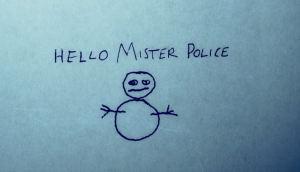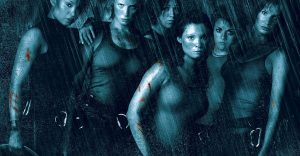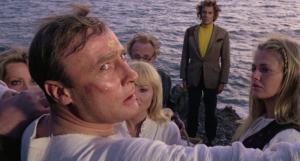Women get it worse in horror films. Sorry, but that’s the truth.
Before you start sighing and rolling your eyes, here’s a thing: I don’t identify as a feminist. Sure, I know I’m female, and I staunchly and firmly believe in equality, but I find the idea of feminism a bit nuanced and tricky for me to comfortably pledge my allegiance without thinking about it carefully, so I prefer to just continue trying to do my bit to ensure society is non-divisive and doesn’t discriminate or make anyone feel like shit, regardless of colour, gender, sexuality, mental or physical state. And that means looking at women in horror, who, by and large (in my view at least), still seem to get the short end of the bloody straw.
That being said, as a woman, particularly a woman who writes horror, I am naturally and no doubt subconsciously more sensitive to certain things where other women are involved, and one of those things is this: women DEFINITELY pull the short straw when it comes to horror. I’m talking that old-hat trope ‘The Final Girl’, and why I struggle with it as a concept.
Final Girl Syndrome
Bear with me and I’ll elaborate. Please note: I do not possess a handbag, and I am not clobbering anyone with it. And I watch a LOT of horror.
So I’m sick. I’m lying in bed surrounded by the debris of a cold: snotty tissues, various electronic devices, empty cups piling up around me. I’m treating myself to a well deserved horror and crime movie binge, because nothing makes you feel less like dying yourself than watching the pain and suffering of others (caveat: pain and suffering of fictional characters only.)

The Snowman, image courtesy of Cineworld
First on the list is The Snowman. This is for a few reasons: I adore norwegian and scandi noir, I adore Michael Fassbender (most of the time, Assassin’s Creed was proper shite) and I adore Jo Nesbo’s writing. It’s one of those films I consider a crime/horror/thriller hybrid, the best type, in my humble opinion.
But. I am twenty minutes in, and so far, one woman has been dissected and is laying in pieces in a snowbank, one woman has been beaten, raped and drowned herself, and another five are missing. So I take a break, and start thinking about how common a motif this is: a serial killer on the loose, doing awful and unspeakable things to a large number of females in an attempt to exorcise some childhood abuse and neglect.
I’ve even been guilty of using this exact same device in an old novel I worked hard on before I abandoned it: a serial killer on the loose in Vietnam, collecting hair samples and drowning young, nubile girls, left, right and centre. Sure, he got his just desserts in the end- at the hands of the female protagonist, of course- but that’s not the point. Wasn’t there something else I could have written about? Why not a string of men lying dead in bathtubs and ponds and lakes and swimming pools? Where are the female serial killers? We have a few- Misery (all hail Kathy Bates) and Monster spring to mind- I also wrote about Ellie, featured in my last post- but it just feels like we don’t ever seemed to get bored of the idea of men with mummy issues slashing their way through ranks of unsuspecting women.
Hmm.

Don’t get too attached to this bunch
In my mind, it’s a common misconception that ‘the final girl’ is a representation of women performing better in the survival stakes in scary movies. For every ‘final girl’ in every slasher film, there is a trail of other ‘unfinal girls’ who were not so lucky. Usual body counts for these things seem to average at around four to five corpses, mostly female, before the final girl makes it out alive. Take, as evidence: The Descent, any of the Scream franchise, The Silence of the Lambs, I could go on.
These women are ‘ass-kickers’, apparently. And, yes, there is a strong trend for strong women in many of these films (hello Sigourney Weaver, my hero) but from what I can see, the majority of Final Girls who survive the average B-movie mostly just get lucky, fate being the only reason they escape with only a life-time of PTSD ahead of them to look forward to.
And then take Wolf Creek, which I won’t watch again, because it offends even me a bit too much (it takes a fair bit to offend me). The Final Girl in this film is actually a Final Guy– yet we all know which famous real-life murder case this film is loosely based on, and we all know that the real life survivor was actually female. Why was it so difficult to translate this to film? Is it somehow more believable that the man survives and the woman does not? Is this down to purely practical reasoning- we’re smaller, weaker, therefore more easy to overcome?
Finding a new purpose in horror fiction- a woman who isn’t a victim
I’ll tell you why this bothers me all of a sudden.
I’m sitting here thinking about my next story, which features a woman who is being stalked by a man. Now, this happens, and I know it happens. What I do not know is where the story should go next.
My first instinct about my current stalker story was thus: the stalker is a serial killer, and he has chosen our protagonist as his next victim, along the lines of The Fall- which again, has a familiar menu of helpless female victims on offer, mediated by a few token male victims, one survivor and Gillian Anderson as a deliberately masculine character.
I stop, mid-sentence, about to type up the discovery of my first innocent female corpse.
I just can’t, anymore.
Why it matters to me- we want to survive
At this point, I should also confess something.
About five years ago I was attacked from behind and aggressively mugged by two masked men, who stole my handbag (this is why I don’t have one anymore), but not before punching me multiple times in the head and then some, and running away. I escaped- physically- with some bruises, a swollen face and a few nice new ring marks tattooed onto my nose. Mentally, I didn’t do so well.
While it was happening, I froze. I didn’t fight back. I rolled up into a ball, screamed like a child, and accepted I could do nothing. I was furious with myself for years afterwards until a very clever victim support counsellor told me that it was, in fact, okay to do nothing- because this is sometimes how we survive. They could have been carrying knives. They could have done much worse than run off with a cheap fake leather bag and a second-hand smartphone.
So here’s the rub- this made me, in that moment in time, the weaker of the two sexes. And yes, I can see why it is a recurring theme in horror and crime- the female victim. It is actually harder for a lot of us to fight back than I’d like to admit.
But it still pisses me off. The imaginary me would have kicked and punched and fought like a tiger. The imaginary me wanted to give as good as I got, and the real me wants to see more of the imaginary me surviving in horror films, not being a victim.

Sorry, Edward. But it made for a great movie.
So I start thinking about the movies where the male lead/ leads die, and how- and I know how this will sounds, but still- I think about how they are always such good films. Wicker Man. Gerald’s Game. Saw. Cabin in the Woods. The Shining. Many of them were genre-inspiring and pioneering in their own way. All of them have made it onto ‘top 10’ lists and whatnot.
I’m still stuck as to what to do with my story, my female protagonist and her mysterious stalker. But I know this- she won’t be a victim. Not on my watch.
Women in horror: victims no more? I’m not convinced.